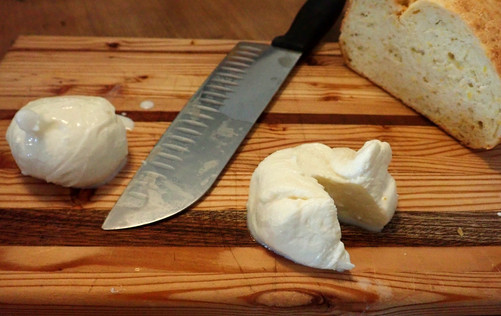Mozzarella and Burrata, take 3, a success story
- Nightingale

- May 24, 2021
- 3 min read
Last week I tried mozzarella again for the third time. As you may remember, my previous two attempts left something to be desired. This time I started out with my cousin-in-law's recipe crossed with the recipe from my kit - not knowing what type of rennet she uses I referred to the kit for that.
Initially the milk reacted the same as on previous attempts, and while it curdled a little, it didn't form nearly the same amount nor consistency of curds that it should have. I then realised that although her recipe didn't call for it, I probably needed to use calcium chloride as my milk is pasteurised at the dairy whereas hers probably isn't. On a whim I also added another rennet tablet and low and behold, the curds appeared! I don't know if it was the calcium chloride or the extra rennet tablet that did it, but I suspect it was the rennet as I had used calcium chloride on my previous attempts.
Initially the curdling wasn't tremendously obvious and I started draining the curds through just a strainer without a cheese cloth. As they went through though, gel-like curds formed in the whey underneath. I therefore lined my strainer with a cloth and restrained all the whey and got a large amount of curds. When submerged in the warm water, they stretched the way they are supposed to and based on that I decided to make burrata too.
What I discovered though was that I had two types of curd. In the bottom of the strainer, below the lovely, smooth, stretchable curds were lumpy gritty ones that were reacting the same way as the ones from my second attempt, dispersing in the hot water instead of melting. I believe that these were formed before the second rennet tablet had time to really take effect.
At lunch an hour or so after making the mozzarella, both cheeses were perfect. Taste and texture were both as they should be. Well, not perfect as I've had better - fishing it out of a plastic bag of whey on my lap in a moving car after we picked up fresh mozzarella at a farmers' market in Genoa - but as good or better than even the best store-bought mozzarella I have had.
The next day however, both the mozzarella and the burrata were tough. Based on the trouble shooting table in Artisan Cheese Making at Home, I added too much rennet, so next time I will try to use only one and a half tablets and see where that gets me. I will also add the calcium chloride at the very start as I am supposed to, rather than mid way through, after the citric acid and after some but not all of the rennet. I wonder if some of the trouble each time was adding the citric acid first rather than the calcium chloride first. I only discovered this time, when checking the effect of the calcium chloride, that it is supposed to be added at the very start and is used in pasteurised milk to increase calcium ion availability and thus to improve curdling.
Even a little tough though, the taste of the cheese was great! We didn't cook with either the mozzarella or the burrata at all but ate it on the side with lunch. I will obviously be playing around with this again and see how it goes, but for a nice meal, it is worth the effort. For bog standard mozzarella uses though, I think I'll stick with store-bought.
On a side note, I made this batch of cheese with very wet feet in an increasingly flooded kitchen. Little Bit asked to have water play time at the sink in his observation tower, and figuring it would occupy him nicely while I stretched hot curds, I thought this a good idea. It was. He was delighted, but between his dumper truck and a bucket, he managed to make quite the mess. It took some cleaning up while the cheese cooled in its salt water after wards, and we both needed fresh socks - and he a whole outfit change - but that's ok.
In other news, I have contacted a cheese making supply company here in Switzerland, so hopefully I will be getting cultures soon and able to move on to other cheeses....










Comments